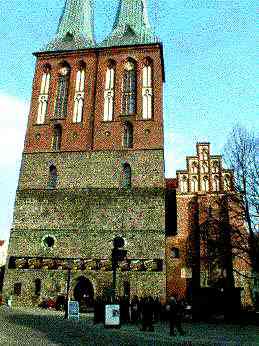 |
| Nikolaikirche (Nikolai church)
Built in 1230 A.D., one of the oldest buildings in Berlin.
This is where Berlin emerged. |
Having anticipated that the coming new century is for Berlin, I stepped
into the city for the first time. It has just resumed the status of
the capital of Germany in 1999, ten years after the memorable reunion.
I had been interested in the city for 15 years, yet never really had
a chance to visit. What interested me most was the decadent culture
young West Berliners enjoyed in the late 80's. They found themselves
in destructive noise music, art, and so on. The uncertainty of being
in a hostage-like situation, left within the Eastern part, might have
been the cause of the decadence. While the name Berlin is gaining recognition
day by day, I finally made up my mind to see how things have changed
since then.
To be honest, as I had expected more excitement, I found it rather
quiet. But the more I looked at it carefully, the more I found it interesting.
During its separation period, Berlin was a showcase, as both West and
East were competing by displaying their most advanced buildings to each
other. In terms of height, the Western part won. It is true that, apart
from the Mitte district in the Eastern part-where Sony, Daimler Benz,
and others are proud of their modern buildings-other parts of the former
East Berlin, particularly residential areas, do not seem to have changed
since before the War. Many buildings are of similar height: mostly 5-storied
buildings with no lifts. Also, if a condition of being a big city is
to have an underground, only the Western part can qualify. In the Eastern
part, the tram is still the most popular means of transportation for
citizens, which gives the Eastern part a nostalgic relish.
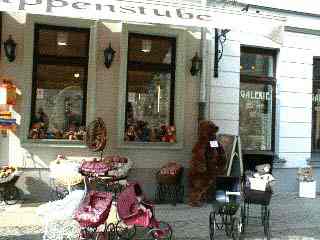 |
| Souvenir shop in front
of Nikolaikirche
The bear is the symbol of Berlin, and this lovely souvenir
shop displays them. You can find remembrance replica goods such
as toy-Trabant from the Eastern period at this shop. |
It's often said that, even if it has been ten years since the reunion,
the Eastern economy has not recovered, that the economical winners come
from the Western side. This may be true; however, when it comes to the
cultural side, the Eastern part takes the lead. The several abandoned
buildings that are formerly factories or company buildings are suitable
for artists who squat those places for their 'rent-free' atelier. Tacheles
is one of those buildings which has now become a tourist's favorite.
Tacheles and other similar places are forming artistic sites that attract
galleries, and the galleries attract fashionable people. Then cafes
follow and the whole area became prosperous. It is now the most exciting
spot in Berlin, and the artistic spots in the Western part can hardly
catch up as they are too established.
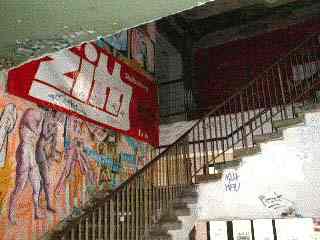 |
| Inside of Tacheles
Tacheles, a ruin of an ex-East German building squatted in
by artists. The walls of the interior are full of graffiti. |
Hackescher Hof, an old housing complex which has the facade of a 19th-century
look resembling Viennese Klimt-designed ones, with bars, cafes, cinema
and so on, accentuates the area. On weekends, people hung around till
late. Not only does the art scene flourish there, but theatre and dance
performances as well. Each night, spectators queue up outside to get
tickets for those performances. The most unmissable thing in Berlin,
however, is the night clubbing, according to repeating foreign visitors
to the city. They say that good events are likely to be taking place
in the basements of the abandoned buildings, secretly. The guests are
the chosen few who can get the information about the venue, date, time
and so on by word of mouth or e-mail so that they can keep outsiders
shut out. This is how the Berlin night club scene remains fresh.
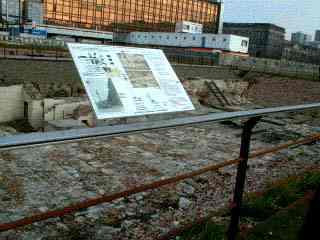 |
| Ruin of the Palace
The palace was demolished by World War II, apart from one
remaining facade which was adopted to a governmental building
of the DDR. Now the ruin is an open space. |
The entertainment is just another face of Berlin; the casual Berlin
is rather quiet. However, I am sure that it will turn out to be the
busiest big city and become the centre of Europe in both culture and
business in five years time, just like it was in the 19th century. In
the meantime, we have to keep eye on it.
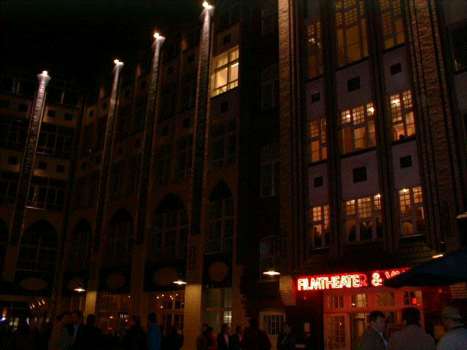 |
| Hackescher Hof at night
on weekend
This Klimt-like old housing complex is an entertainment site
and becomes busy on weekends. |
Travel
& Culture Home




 This
page last updated
November 4, 2002
. E-mail Tim
This
page last updated
November 4, 2002
. E-mail Tim